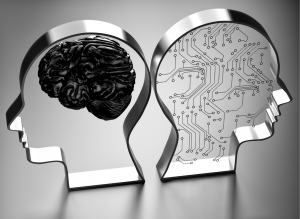On Intelligence and Memory
Apr 21, 2023
In my last article, I wrote about the passing of Gordon Moore and the law coined in his name about the steady march of miniaturization in the field of electronics. Over the coming weeks, I will share a series of reflections on the ways in which the technologies pioneered by Shockley, Moore, Noyce (co-founder of Intel Corporation and inventor of the integrated circuit) and others, have changed our understanding of human communication and intelligence itself.
Moore’s Law states that the number of transistors in a microprocessor will double every two years. Technological advances have proven Moore correct to date, leading to an ever-expanding capacity to capture, store, sort, and retrieve information. In the world of Gordon Moore, the size or capacity of electronic data storage has expanded exponentially over past decades. This has been a quantitative change in which the space available to park information has grown almost beyond human comprehension: the kilobytes (103) and megabytes (106) of the recent past have given way to the gigabytes (109) and terabytes (1012) of the present; the petabytes (1015), exabytes (1018), zettabytes (1021), yottabytes (1024), ronnabytes (1027), quettabytes (1030) of the near and distant future await patiently.
As storage capacity increases, some are speculating about the potential emergence of a qualitative change, a convergence or singularity, in which self-awareness emerges from the sheer volume of data stored. One needs to keep in mind, however, that increasing the size of storage capacity does not, in and of itself, create the conditions for the emergence or evolution of a self-organizing, self-perpetuating system or systems. More is not necessarily ‘better’ – just more. In the world of data, the qualitative change needed to achieve higher order ability to organize and ‘think’ about data is a part of the search for a better understanding of the nature of ‘intelligence’.
As the volume of human data expands, there has been a great deal of speculation about the nature of intelligence. The recent dramatic emergence of data-driven technologies and systems that seem to mimic certain aspects of human intelligence has been unsettling for many. For some, the apparent creation of intelligence by ‘artifice’ is revelatory, for others, it is foreboding portent of a future dystopian nightmare. Does putting so much data in one place create conditions analogous to the ‘critical mass’ needed for nuclear fission? While an interesting idea for fiction, the nature of data is quite unlike that of the enriched materials used for atomic chain reactions. Data still needs an organizing intelligence to create information, leading to knowledge. However, regardless of viewpoint, it is perhaps timely to take a moment to reflect on the nature of intelligence itself and the ways in which intelligence and data interact through memory.
The study of intelligence has been one of the central focal points for the cognitive sciences that came to prominence in the 20th century (including: philosophy, psychology, anthropology, linguistics, neuroscience, and artificial intelligence). Its study has a relatively short history. Scientific experiments on the nature of intelligence involving human subjects are constrained by strong ethical and methodological limitations, so researchers have explored manifestations of intelligence in animals, usually through learned problem solving. These are typically primed by providing an incentive – sustenance – to motivate the problem-solver. The choice is one of life or death. Animals, being motivated by their survival instinct, engage in various activities that attempt to show how behavior can be learned or modified with stimuli and how memories are formed and accessed. There is still a great deal to learn.
In contrast to living organisms, an artefact, by definition, has no choice: it must, by virtue of its design, follow its programming. It can perhaps give the appearance of moving beyond the bounds of its programming, but only in so far as these excursions are themselves a part of the program itself. It has no innate sense of its own survival or mortality. It operates in accordance with its operational parameters and limitations.
Beyond mere survival and replication, artificial systems have been designed and made to operate, and those operations, if designed correctly, may present solutions to certain prepared human questions or problems. The mimicry of human forms of interaction, physically, linguistically, semantically, and culturally that are manifested by these systems are all carefully curated products of programming in depth, in which the essential features of human communication have been captured in the design of the artefact itself. When the huge cache of human communication is available to a ‘connected’ artefact that can search, parse, phrase, rephrase, reconstruct, and respond in seemingly real ‘human time’, human interlocutors feel they are indeed interacting with a human ‘intelligence’. The ability of ‘an intelligence’ to answer questions and solve problems is simply marvelous. Quite so. But what does it mean?

For artificial intelligence systems (AI), the potentially infinite capacity to answer questions, given sufficient resources, seems remarkable, even transcendent. Yet, what is actually taking place during human-AI interactions? In fact, human subjects are engaged in a curated dialogue with a great many pre-recorded conversations that have been distilled and refined to fit the circumstances of the immediate interaction. The basic programming principle is one of probability. This is a manifestation of careful programming and expansive memory, but perhaps not intelligence itself.
Put simply, if memory (capture, storage, and recall) can now be made or mimicked, how might we arrive at a more refined definition of intelligence? If we can no longer equate prodigious memory with intelligence, we need a better yardstick. We might also consider the consequences of living in a world where nothing is ever forgotten. If infinite storage and recall is now an integral part of the living fabric of the human experience, what moral, legal, and social challenges does this pose for each of us?
Dr. Malcolm Pritchard
Head of School
